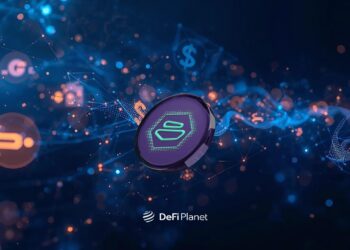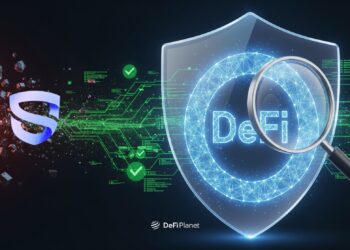Last updated on July 31st, 2025 at 11:55 am
The DeFi space is full of innovation, but with so many protocols promising faster trades, deeper liquidity, and better user experiences, it’s easy to get lost in the noise. One area drawing serious attention is decentralized derivatives, where traders can access futures and perpetuals without giving up custody or control.
Drift Protocol is one of the most talked-about names in this space. Built on Solana by Cindy Leow and David Lu, Drift aims to bring speed, capital efficiency, and professional-grade trading tools to on-chain derivatives. Its latest upgrade, Drift Protocol v2, promises even tighter spreads, improved risk management, and new features to rival centralized exchanges.
But with bold claims and big ambitions, the real question is: Is Drift v2 truly pushing the boundaries of DeFi trading, or is it just another iteration riding the hype?
In this review, we’ll unpack Drift’s newest features, break down its innovative mechanisms, and assess whether Drift Protocol v2 has what it takes to lead the next wave of decentralized derivatives on Solana.
What is Drift Protocol?
Drift Protocol v2 is a decentralized exchange (DEX) that focuses on letting people trade perpetual futures, a type of crypto derivative, without giving up control of their funds. The big goal? To offer a trading experience just as fast and smooth as the big centralized platforms, but with all the benefits of DeFi: low fees, full transparency, and no middlemen.
Because Drift is built on the Solana blockchain, it’s super fast and cheap to use. It offers things like cross-margin trading, up to 50x leverage on big trading pairs, and smart systems for managing liquidity. It also connects easily with other Solana apps, making it more efficient and user-friendly.
How Does Drift Protocol v2 Work?
Drift v2 takes decentralized trading on Solana to the next level with a blend of cutting-edge liquidity mechanisms, smart margin management, and lightning-fast execution.
At the core of Drift Protocol v2 is the Smart Margin system, a unified account architecture that simplifies risk and capital management. Traders can manage multiple positions, spot, perpetuals, and margin trades, using a single margin account.
The system supports both cross-margin and isolated-margin, automatically recalibrating margin requirements based on portfolio risk and market conditions. This dynamic approach helps reduce liquidations and maximizes capital efficiency.
Drift Protocol v2 introduces a hybrid liquidity system composed of three distinct components that work together to guarantee optimal execution for every trade:
- Just-in-Time (JIT) Liquidity
When a trader submits a market order, it triggers a Dutch auction broadcast to a network of market makers, including “guardians.”
These makers compete in real-time to fill the order instantly, often leading to zero slippage and highly efficient price discovery. JIT ensures that liquidity is provided precisely when needed, instead of locking capital in idle pools.
- vAMM Liquidity
If JIT doesn’t fully fill an order, Drift’s virtual Automated Market Maker (vAMM) steps in as a reliable backup. Drift’s vAMM includes built-in bid/ask spreads and integrates Drift Liquidity Providers (DLPs), passive LPs who can earn from trading fees by supplying liquidity.
The system also features an oracle-based pricing model that dynamically adjusts spreads based on volatility and inventory. This ensures a balanced market and reduces issues like long-short imbalance.
- Decentralized Limit Order Book (DLOB)
Drift maintains a decentralized order book powered by a network of bots called Keepers. These bots manage off-chain order books and execute trades by matching buy and sell orders with identical terms, without routing through the vAMM.
This peer-to-peer matching improves speed and reduces costs, while still rewarding Keepers through a formula-based fee-sharing mechanism.
All of Drift’s performance is supercharged by Solana’s high-speed infrastructure, enabling sub-second execution and ultra-low fees, often less than a cent per transaction. Traders can execute high-frequency or multi-leg strategies with minimal latency and full self-custody of funds.
Other Features That Set Drift v2 Apart
Drift Protocol v2 is loaded with advanced features that enhance the decentralized trading experience:
Risk Engine Upgrades and Better Liquidation Mechanisms
Drift v2 has made significant improvements to its risk engine, which powers the platform’s liquidation system. The updated risk model automatically adjusts margin requirements based on portfolio risk and market conditions, reducing the chance of unexpected liquidations.
This gives traders more flexibility and security when managing their positions. Additionally, Drift v2 introduces dynamic liquidation mechanics, making liquidations more accurate and timely, which helps minimize negative impacts on the market.
Improved UX: Gasless Trading and Simplified Onboarding
Drift v2 is designed with user experience at its core, providing a smooth trading environment for both experienced traders and beginners. One standout feature is gasless trading on Solana blockchain, allowing users to trade without paying transaction fees directly.
This reduces friction and enhances the overall experience. Onboarding has also been simplified, making it easier for new users to get started. Whether you’re a seasoned pro or a newcomer, the interface is optimized for speed and ease of use, ensuring a quick and seamless navigation experience.
Integration with Solana-Native Wallets and Tools
Drift v2 is fully integrated with Solana’s ecosystem, enabling users to connect easily with Solana-native wallets, such as Phantom and Sollet. This integration ensures secure access to funds and efficient interaction with the platform, while also benefiting from Solana’s fast transaction speeds and low fees.
Additionally, Drift v2 works seamlessly with other Solana-native tools and services, making it an ideal platform for users already familiar with the Solana blockchain. Native compatibility with Solana ensures a fully integrated, frictionless trading experience.
Comparison with Other DeFi derivatives platforms: How Does Drift Protocol v2 Stack Up?
Here’s a clear side-by-side comparison of how Solana’s Driftv2 compare to existing competitors:
 Market Impact: Is Drift v2 a Threat to Centralized Platforms?
Market Impact: Is Drift v2 a Threat to Centralized Platforms?
Drift Protocol v2 is quickly becoming a serious player in the crypto trading world, not just among decentralized platforms, but as real competition to centralized exchanges like Binance and Bybit. With features like near-instant trade execution, smart margin accounts, and a user-friendly interface, Drift is narrowing the gap between the convenience of centralized exchanges and the transparency of DeFi.
One of Drift’s strongest advantages is its accessibility. It’s simple enough for everyday traders to use, but still powerful enough for professional and institutional players. Gasless trades, fast speeds, and low slippage make it especially attractive to high-frequency and algo traders—groups that usually stick to centralized exchanges for performance. At the same time, Drift’s unified margin system and hybrid liquidity model make trading smoother and less complicated for newcomers.
Adoption-wise, Drift v2 is gaining traction. Its Total Value Locked (TVL) is growing steadily, fueled by both active users and liquidity providers who are drawn to its unique setup. Developer interest is rising too, thanks to Drift’s easy integrations with Solana-native wallets and tools, which make building on or using the platform even simpler.
If this momentum keeps up, and Solana’s network stays stable, Drift v2 could help shift more liquidity and users away from centralized platforms, playing a big role in the move toward a more decentralized future for crypto trading.
Challenges & Risks of Drift Protocol v2
While Drift v2 introduces cutting-edge features and a seamless trading experience on Solana, it also faces several challenges:

Solana Downtime Risk
Drift v2 is built on Solana, a blockchain known for its high speed and low fees. However, Solana has experienced several periods of downtime in the past due to bugs, network congestion, or issues with validators.
When Solana goes offline or lags, Drift v2’s functionality, like executing trades or updating prices, can be disrupted. This is especially risky during periods of high volatility when timing is everything.
Liquidity Depth and Volatility
Although Drift v2 uses an innovative hybrid liquidity system, it still relies on active market makers and liquidity providers to function smoothly.
In less active markets or during sharp price swings, liquidity may dry up, leading to higher slippage or failed trades. This can negatively affect the trading experience and outcomes for users relying on fast, precise order execution.
Regulatory Uncertainty
Decentralized derivatives platforms like Drift Protocol v2 operate in a murky regulatory landscape. Countries such as the U.S. are increasing scrutiny on leveraged and speculative financial products in the crypto sector.
While Drift is permissionless and decentralized, regulatory bodies could still impose restrictions, enforce geo-blocking, or target developers and users, creating uncertainty around long-term access and compliance.
Security Concerns and Audit History
Smart contracts are powerful but not foolproof. Drift v2 has been audited by firms like OtterSec, which helps reduce risk, but no audit can guarantee complete safety.
Bugs in the smart margin system, vulnerabilities in Keeper bots, or exploit paths in its liquidity mechanisms could result in the loss of funds. Continuous auditing, community monitoring, and robust bug bounty programs are essential for maintaining user trust and platform resilience.
Real Disruptor or Just Another DeFi Hype Cycle?
Drift Protocol v2 brings real innovation to the table. With its hybrid liquidity engine, smart margin system, and lightning-fast trade execution on Solana, it’s clearly not just a minor upgrade. The protocol shows strong promise in solving some of the biggest pain points in DeFi trading, including slippage, slow execution, and capital inefficiency.
Drift v2 is one of the most complete DeFi trading platforms to emerge from the Solana blockchain. Whether it becomes a lasting disruptor or gets caught in the waves of the next DeFi cycle will largely depend on how well it executes its roadmap, secures strategic partnerships, and adapts to an evolving market.
Drift v2 isn’t just hype, it’s built with purpose. However, like everything in crypto, the next few months will determine whether it takes off or fades.
Disclaimer: This article is intended solely for informational purposes and should not be considered trading or investment advice. Nothing herein should be construed as financial, legal, or tax advice. Trading or investing in cryptocurrencies carries a considerable risk of financial loss. Always conduct due diligence.
If you would like to read more articles like this, visit DeFi Planet and follow us on Twitter, LinkedIn, Facebook, Instagram, and CoinMarketCap Community.
Take control of your crypto portfolio with MARKETS PRO, DeFi Planet’s suite of analytics tools.”





















